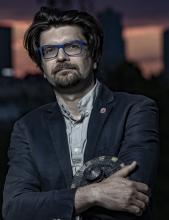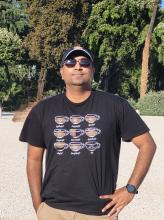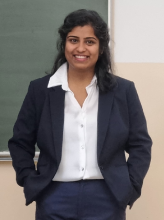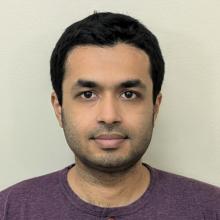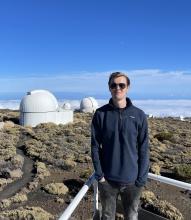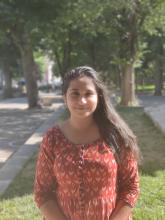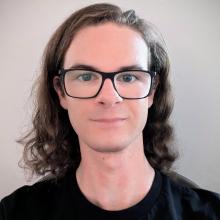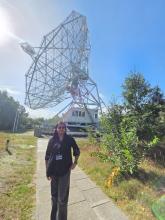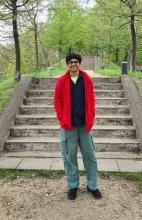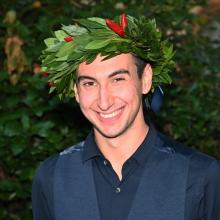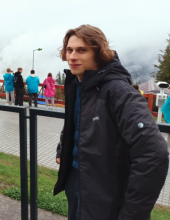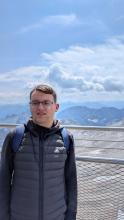Current employees
Senior staff
Office: 520
Phone number: +48 22 273 2841
E-mail: name.lastname (at) domain
Domain: ncbj(.)gov(.)pl
(Email does not contain special characters)
Science interests:
My expertise covers spectral energy distribution fitting, implementing machine learning algorithms for astrophysical data, spectroscopic redshift measurements, and optical counterparts for gamma ray burst (it was a topic of my master thesis and a part of my PhD thesis). I am also a dedicated supervisor. I particularly enjoy working with young researchers and inspiring them to pursue a scientific career. My current research activities focus on modelling spectral energy distribution of galaxies observed from optical to far infrared wavelengths. I am mostly working with infrared detected galaxies; I enjoy engaging in public outreach activities, where I can tell other people about my passion.
Office: 217
Phone number: +48 22 273 2801
E-mail: name.lastname (at) domain
Domain: ncbj(.)gov(.)pl
(Email does not contain special characters)
Office: 208
Phone number: +48 22 273 2840
E-mail: name.lastname (at) domain
Domain: ncbj(.)gov(.)pl
(Email does not contain special characters)
Grant NCN MAESTRO: Barely visible
Office: 502
Phone number: +48 22 273 2844
E-mail: name.lastname (at) domain
Domain: ncbj(.)gov(.)pl
(Email does not contain special characters)
Science interests:
My research interests comprise theoretical and observational cosmology, gravitational lensing and gravitational waves. In particular I'm interested in development of new cosmological probes alternative or complementary to the standard ones like SNIa, BAO and CMB. Such new probes could be strong gravitational lensing systems combined with stellar kinematics of lensing galaxies, miliarcsecond compact radio sources of intermediate luminosity, QSOs observed in UV and X-ray calibrated as standard candles, cosmic chronometers or standard sirens (gravitational waves from inspiralling compact binary systems). Currently I'm interested in testing various aspects of accelerated expasnion of the Universe (so called dark energy problem), determination of cosmic curvature from local cosmological probes and testing General Relativity against modified gravity theories. My past interests comprised: multidimensional cosmological models, theory and applications of dynamical systems and invariant description of deterministic chaos in General Relativity.
Office: 503
Phone number: +48 22 273 2844
E-mail: name.lastname (at) domain
Domain: ncbj(.)gov(.)pl
(Email does not contain special characters)
Science interests:
I am the leader of Polgraw group (https://polgraw.camk.edu.pl/pl/) - a member of the Virgo gravitational wave detector project (http://www.virgo-gw.eu/). The groups has 26 members from 9 Polish institutions (including NCBJ). Virgo Project collaborates closely with the LIGO Project (https://www.ligo.org/). By Memorandum of Understanding between LIGO and Virgo, all analyses are performed jointly by common data analysis groups.
I specialize in searches for gravitational wave signals from rotating neutron stars. I have developed a number of pipelines to search for such signals. The pipelines are used for the analysis of LIGO and Virgo data and resulted in several publications of the LIGO - Virgo consortium.
List of publications:
- P. Jaranowski and A. Królak, Optimal solution of the inverse problem for the gravitational wave signal of a coalescing compact binary, Phys. Rev. D49 (1994) 1723.
- P. Jaranowski, A. Królak, and B. F. Schutz, Data analysis of gravitational-wave signals from pulsars. I. The signal and its detection, Phys. Rev. D58 (1998) 063001.
- A. Królak, M. Vallisneri, and M. Tinto, Optimal filtering of the LISA data, Physical Review D70 (2004) 022003.
- P. Astone, K. Borkowski, P. Jaranowski, M. Pietka and A. Królak, Data analysis of gravitational-wave signals from spinning neutron stars. V. A narrow-band all-sky search, Physical Review D82 022005 (2010).
- B.P. Abbott et al, Implementation of an F-statistic all-sky search for continuous gravitational waves in Virgo VSR1 data, Class. Quantum Grav. Vol. 31 (2014) 165014. LSC - Virgo Collaboration paper.
- All authors of the LIGO Scientific Collaboration and Virgo Collaboration, Observation of Gravitational Waves from a Binary Black Hole Merger, Phys. Rev. Lett 116 061102 (2016)
- All authors of the LIGO Scientific Collaboration and Virgo Collaboration, GW170817: Observation of Gravitational Waves from a Binary Neutron Star Inspiral, Phys. Rev. Lett 119 161101 (2017)
Monograph
- Analysis of Gravitational-Wave Data, P. Jaranowski and A. Królak, Cambridge University Press, Cambridge 2009.
Office: 502
Phone number: +48 22 273 2843
E-mail: name.lastname (at) domain
Domain: ncbj(.)gov(.)pl
(Email does not contain special characters)
Science interests:
Łukasz Wyrzykowski (pronounced Woo-cash Vi-zhi-kov-ski) is a Professor of Astronomy and the leader of the NCBJ's contribution to the ACME European Grant. He specializes in observational astronomy and data modeling, with a focus on applying machine-learning techniques to large astronomical datasets. He has been a key contributor to the ESA's Gaia space mission and is the initiator and main coordinator of BHTOM.space, a global telescope network dedicated to time-domain observations of astrophysical objects. As a principal investigator on numerous grants funded by Poland and the European Commission, he has published research in top-tier journals, including Nature and Science. Łukasz holds a PhD and professorship from the University of Warsaw and has conducted research at leading institutions worldwide, such as the University of Cambridge, Tel Aviv University, and Princeton University.
Office: 505
Phone number: +48 22 273 2842
E-mail: name.lastname (at) domain
Domain: ncbj(.)gov(.)pl
(Email does not contain special characters)
Science interests:
- Proton structure and QCD features
- High Energy Cosmic Rays
- Gamma Ray Spectroscopy in Astronomy (Gamma Ray Bursts and Solar Flares)
Office: 518
Phone number: +48 22 273 2848
E-mail: name.lastname (at) domain
Domain: ncbj(.)gov(.)pl
(Email does not contain special characters)
Science interests:
My research interests include studies of the cosmic microwave background (CMB), type Ia supernovae as well as radio and galaxy surveys. In particular I'm interested in studying observational constraints on cosmological models using statistical properties of CMB maps and distribution of type Ia supernovae, gravitational lensing of the CMB and cross-correlations between CMB and other tracers of the large-scale structure of the Universe.
Junior staff
Office: 505
Phone number: +48 22 273 2846
E-mail: name.lastname (at) domain
Domain: ncbj(.)gov(.)pl
(Email does not contain special characters)
Science interests:
My research is mainly related to the study of the chemical evolution of galaxies and of dust in different environments, in particular in the interstellar medium of local and distant galaxies, and in the outflow of evolved low and intermediate-mass stars that lose mass during the thermally pulsing asymptotic giant branch (TP-AGB) phase. Specifically, I am interested in studying how dust grains are condensed and destroyed, in characterizing their chemical composition, size and optical properties, and in investigating the implications for the spectro-photometric evolution of galaxies.
Office: 509
Phone number: +48 22 273 2832
E-mail: name.lastname (at) domain
Domain: ncbj(.)gov(.)pl
(Email does not contain special characters)
Science interests:
I am an observational astrophysicist specialising in extragalactic radio sources, with a focus on active galactic nuclei (AGN), giant radio galaxies, and galaxy clusters. As Principal Investigator of the SAGAN project, I aim to advance our understanding of giant radio galaxies and their use as probes of astrophysical processes. My research integrates multi-wavelength data across radio, optical, infrared, and X-ray regimes to investigate the physical mechanisms driving AGN activity and jet-environment interactions. I have extensive experience with major radio facilities, including uGMRT, LOFAR, and JVLA, and am an active member of the LOFAR Surveys and SKA Continuum Science Working Group. I also lead the newly approved uGMRT DHRUV survey, the first deep, wide-field survey at 650 MHz. Beyond research, I am passionate about science communication and public outreach, and enjoy sharing the wonders of astronomy with broader audiences.
Office: 504
Phone number: +48 22 273 2819
E-mail: name.lastname (at) domain
Domain: ncbj(.)gov(.)pl
(Email does not contain special characters)
Science interests:
My research focuses on understanding galaxy formation and evolution, with a particular emphasis on merger-driven systems such as Ultra/Luminous Infrared Galaxies (U/LIRGs). I primarily utilize multiwavelength spectral energy distribution (SED) modeling to uncover the physical properties of these galaxies. My work bridges the gap between ultraviolet (UV)-infrared (IR) and radio-only SED modeling techniques, which have traditionally been pursued independently. By integrating these two regimes, I aim to capture the interconnectedness of the underlying physical processes and gain a more holistic understanding of galaxy evolution. Further, in preparation for the upcoming large volume of data from surveys such as LSST and Euclid, I am currently exploring the application of machine learning algorithms to identify pre- and post-merger galaxies and plan to study their dust-related properties. I am also passionate about outreach and enjoy sharing my enthusiasm for astronomy through public talks and related activities.
Office: 506
Phone number: +48 22 273 2837
E-mail: name.lastname (at) domain
Domain: ncbj(.)gov(.)pl
(Email does not contain special characters)
Science interests:
My research focuses on distant galaxy formation and evolution. In other words, I am curious about the life of massive galaxies in the Universe, from the earliest cosmic times after the Big Bang to the present day. In my research, I unite theoretical models and panchromatic observations with the largest telescopes (e.g., NOEMA, JCMT, ALMA) in order to tackle some of big questions, such as: how the dust, gas and metals in galaxies evolve over cosmic time. I am a PI of NCN SONATA16 funded project Dusty Giants, which explores large-scale environments of dusty galaxies at high-redshifts. Beside astrophysics and cosmology, I am also professionally involved in the field of science communication as a lecturer and author.
GRANT NCN SONATA: Dusty Giants
Office: 503
Phone number: +48 22 273 2844
E-mail: name.lastname (at) domain
Domain: ncbj(.)gov(.)pl
(Email does not contain special characters)
Science interests:
My main field of interests includes: multi-messenger astronomy and gravitational wave astrophysics. I make analyse of data from gravitational waves detectors (LIGO, VIRGO).
Office: 522
Phone number: +48 22 273 2847
E-mail: name.lastname (at) domain
Domain: ncbj(.)gov(.)pl
(Email does not contain special characters)
Science interests:
My main field of interests includes: observational cosmology, galaxy evolution, and statistical analyses of the large scale structure of the Universe - both theoretical and observational. My recent work mainly focuses on the studies of galaxy clustering dependencies within Halo Occupation Distribution (HOD) models framework using high redshift galaxy surveys (e.g., VUDS, VIPERS). I also work on improving classical models of halo occupation by adding more realistic descriptions of dark matter halo shape and mass distribution.
Office: 519
Phone number: +48 22 273 2840
E-mail: name.lastname (at) domain
Domain: ncbj(.)gov(.)pl
(Email does not contain special characters)
Science interests:
My expertise lies at the intersection of galaxy clusters, software development, and statistical analysis. I have worked on weak lensing and multi-wavelength analysis of galaxy clusters. A key focus of my work has been to develop statistical methods to reliably measure extremely faint sources using "forced measurement". More recently, I have shifted my focus to the application of machine learning methods to analyze massive datasets. At NCBJ I primarily work on the "Barely Visible" project, which aims to study the low surface brightness sources in LSST data. This study will shed light on the role such sources play in galaxy formation and the large-scale structure of the Universe.
Office: 505
Phone number: +48 22 273 2846
E-mail: name.firstlastname (at) domain
Domain: ncbj(.)gov(.)pl
(Email does not contain special characters)
Science interests:
My main field of interest is the formation of stars in galaxies. On one side, I am studying the impact of Galactic ionised (HII) regions on the observed young stellar objects at their edges. As 30% of high-mass star formation is found to be located around HII regions, my goal is to understand if triggered star-formation is likely to occur and if it leads preferentially to the formation of high-mass stars. On the other side, I am working with galaxies at low-redshift (z<1) with the aim of obtaining their star-formation rates and understanding their star-forming properties.
GRANT NCN SONATA: Massive Stars
Office: 502
Phone number: +48 22 273 2843
E-mail: name.lastname (at) domain
Domain: ncbj(.)gov(.)pl
(Email does not contain special characters)
Science interests:
My research focuses on comets and asteroids in the solar system, with an emphasis on cometary activity and dust production in short-period comets. I am primarily an observational astronomer, working with data from both large surveys and targeted telescope observations. My previous work has examined dust production in Jupiter-family comets and the detection of low-level sublimation-driven activity in asteroids. My current research involves adapting the BHTOM system for solar system objects and conducting time-domain observations of active comets and interstellar objects using photometric analysis.
Office: 504
Phone number: +48 22 273 2819
E-mail: name.lastname (at) domain
Domain: ncbj(.)gov(.)pl
(Email does not contain special characters)
Science interests:
My current primary research interests focus on the identification and characterization of low surface brightness (LSB) galaxies using large surveys such as LSST. I also work with the surface brightness fluctuations (SBF) distance indicator as well as the study of extragalactic globular clusters using optical and NIR images. Additionally, I have been working with the multi-messenger problem of developing target-of-opportunity observation strategies to search for optical counterparts of binary neutron star (BNS) mergers and to explore synergies between the Vera Rubin Observatory and Einstein Telescope.
Office: 511
Phone number: +48 22 273 2849
E-mail: name.lastname (at) domain
Domain: ncbj(.)gov(.)pl
(Email does not contain special characters)
Science interests:
My research interest include Active Galactic Nuclei and accreting sources. AGN and their brightest counterparts: quasars are the most luminous persistent sources in the universe. They are best known because of distinctive spectral features: optical-UV continuum called the Big Blue Bump, X-ray emission and broad emission lines. I am focused on accretion disc emission which is responsible for optical-UV continuum emission and its interplay with Broad/Intermediate Emission Line Regions as well as their signatures in both emission and absorption. In my work I use both observational data and theoretical models.
Office: 424
Phone number: +48 22 273 2941
E-mail: name.lastname (at) domain
Domain: ncbj(.)gov(.)pl
(Email does not contain special characters)
Science interests:
- Theoretical model atmospheres, gravitational darkening effect and determination of the equation of state of the neutron star
- Isolated neutron star with low magnetic field
- Reduction and modeling of observed X-ray spectra
- X-ray bursters
- White dwarfs
- I am also involved in outreach about astronomy in form of lectures and papers.
Office: 522
Phone number: +48 22 273 2847
E-mail: name.lastname (at) domain
Domain: ncbj(.)gov(.)pl
(Email does not contain special characters)
Science interests:
My interests lie in galaxy formation and evolution and galaxy scale star formation: I want to know why galaxies look the way they do. To do this I examine the statistical properties of galaxies and explore what influences these properties. This is done by using multi-wavelength data, from UV to the sub-mm, to derive the physical properties of galaxies, such as star formation rates or morphologies. I also work at the interface of observations and simulations, comparing what we see with what we think we should be seeing. To do this, I employ a number of different techniques including spectral-energy density (SED) fitting, statistical modelling, image processing and machine learning.
GRANT NCN SONATA: Smashing galaxies into dust
Office: 424
Phone number: +48 22 273 2941
E-mail: name.lastname (at) domain
Domain: ncbj(.)gov(.)pl
(Email does not contain special characters)
GRANT NCN OPUS: Macroscopic Dark Matter
Office: 513
Phone number: +48 22 273 2937
E-mail: name.lastname (at) domain
Domain: ncbj(.)gov(.)pl
(Email does not contain special characters)
Science interests:
I work on projects related to the “Dark Matter and Interstellar Meteor Survey” (DIMS) and the “Joint Experiment Missions for Extreme Universe Space Observatory” (JEM-EUSO). My primary focus is on DIMS, where I have been working on developing instruments, conducting data analysis, and managing operations. Located in Utah’s Sievert Desert at the Telescope Array Experiment facilities, DIMS cameras observe the night sky with the goal of detecting interstellar meteors and a hypothetical form of dark matter known as "nuclearites" or "macros". Additionally, I contribute to the data analysis for the “Multiwavelength Imaging New Instrument for the Extreme Universe Space Observatory” (Mini-EUSO), a highly sensitive telescope aboard the International Space Station. It maps the night-time Earth in the near UV range, aiming to validate the JEM-EUSO program’s observational principle of a space-based detector for Ultra-High Energy Cosmic Ray (UHECR) measurements. Mini-EUSO is also capable of detecting meteors and upper-atmospheric lightning phenomena, such as ELVES. Previously, I was involved in data analysis for the EUSO-SPB1 experiment, which aimed to observe ultra-high-energy cosmic-ray extensive air showers by looking down at the atmosphere with an ultraviolet fluorescence telescope from a suborbital altitude.
Students
Office: 508
Phone number: +48 22 273 2849
E-mail: name.lastname (at) domain
Domain: ncbj(.)gov(.)pl
(Email does not contain special characters)
Science interests:
My main research interest is in galaxy mergers and how to classify them in a reliable and scalable way. Mergers are a crucial aspect of galaxy evolution but even with the recent advances in machine learning, classifying these events remains a challenge. My work focuses on non-parametric morphologies as a method of classifying mergers efficiently and robustly. These methods will be valuable for upcoming surveys such as Euclid and LSST for large scale and reliable merger classifications.
Office: 523
Phone number: +48 22 273 2845
E-mail: name.lastname (at) domain
Domain: ncbj(.)gov(.)pl
(Email does not contain special characters)
Science interests:
My field of interest is weak lensing of the Cosmic Microwave Background (CMB). I mainly work on reconstruction methods of lensing convergence field. My current study includes impact of foreground contamination on the lensing reconstruction bias and my goal is to develop bias-hardened polarisation based estimators for upcoming CMB-S4 survey. Other component of my work includes cross-correlation studies between lensing convergence and tracers of large-scale structures.
Office: 508
Phone number: +48 22 273 2849
E-mail: name.lastname (at) domain
Domain: ncbj(.)gov(.)pl
(Email does not contain special characters)
Science interests:
My research interests include observational cosmology, gravitational lensing, and gravitational waves. I’m also interested in the evolution of galaxies.
Office: 508
Phone number: +48 22 273 2849
E-mail: name.lastname (at) domain
Domain: ncbj(.)gov(.)pl
(Email does not contain special characters)
Science interests:
I'm focused on the cosmological problems, which includes the hubble tension, distance duailty relation and so on.
Office: 508
Phone number: +48 22 273 2849
E-mail: name.lastname (at) domain
Domain: ncbj(.)gov(.)pl
(Email does not contain special characters)
Science interests:
My research interests lie in cosmology and galaxy evolution, with a particular focus on strong gravitational lensing. I am interested in using lensing systems to probe both cosmological parameters and galaxy properties, bridging theoretical models with observational data. My work has evolved from individual cases to statistical analyses of larger samples, where the role of lens galaxies becomes increasingly important. I am also developing interests in galaxy data processing, aiming to integrate lensing-based cosmology with detailed studies of galaxies.
Office: 523
Phone number: +48 22 273 2845
E-mail: name.lastname (at) domain
Domain: ncbj(.)gov(.)pl
(Email does not contain special characters)
Science interests:
My research is focused on observational cosmology and evolution of galaxies. I have also experience with stellar evolution, especially modeling 3D structures of their remnants. Now I use the cutting-edge observations, including JWST, and complete the information with cosmological simulations, such as SIMBA. My main goal is to understand how the interstellar matter of galaxies evolves. In addition to that, I am also interestend in so-called cosmic nuggets, extremely compact and massive galaxies, which are the key to understand the formation of early-type galaxies.
GRANT NCN PRELUDIUM: Listening to the silence
Office: 508
Phone number: +48 22 273 2849
E-mail: name.lastname (at) domain
Domain: ncbj(.)gov(.)pl
(Email does not contain special characters)
Science interests:
I am interested in the interplay between galaxies and their environment, looking for the effects of large scale structures on the evolution of the interstellar medium (ISM). I am currently exploring the environmental effects on the dust component of passive galaxies, focusing on how different feedback processes shape (and are shaped by) their ISM using the SIMBA cosmological hydrodynamic simulations and deep observations from HST, JWST and ALMA.
Office: 523
Phone number: +48 22 273 2845
E-mail: name.lastname (at) domain
Domain: ncbj(.)gov(.)pl
(Email does not contain special characters)
Science interests:
My research focuses on the growth and evolution of radio galaxies, with a particular emphasis on young, compact radio sources that trace the earliest stages of activity. My work will constrain the duty cycle of active galactic nuclei (AGN) and understanding their role in galaxy evolution.
Office: 523
Phone number: +48 22 273 2845
E-mail: name.lastname (at) domain
Domain: ncbj(.)gov(.)pl
(Email does not contain special characters)
Science interests:
My research at NCBJ broadly focuses on using LSST data to analyze and study the physical properties of an intriguing class of galaxies known as Low Surface Brightness Galaxies (LSBs). More generally, I am interested in exploring extragalactic astrophysics across a wide spectrum of EM radiation, as well as utilizing other astrophysical sources to probe the Universe. For my master's thesis, I worked on the particle aspects of Dark Matter (DM) and related astroparticle searches. As a result, I am interested in investigating the mysteries of DM from a cosmological perspective in the future.
Office: 523
Phone number: +48 22 273 2845
E-mail: name.lastname (at) domain
Domain: ncbj(.)gov(.)pl
(Email does not contain special characters)
Science interests:
My research interests primarily focus on cosmology. At NCBJ, I explore this field by studying the weak lensing of the CMB, including cross-correlations with large-scale structure tracer catalogues. Previously, I worked on clustering, specifically the computation and modeling of n-point correlation functions for the ESA Euclid mission.
Office: 523
Phone number: +48 22 273 2845
E-mail: name.lastname (at) domain
Domain: ncbj(.)gov(.)pl
(Email does not contain special characters)
Science interests:
My interests include the Spectral Energy Distribution (SED) fitting of the galaxies using panchromatic data to infer the physical properties of the galaxies situated in local and high redshift universe. I also work on the dust emission models to explain the baryonic cycle processes occurring in the galaxies with the help of chemical evolutionary models to explain the observed parameters with the help of models.
Office: 508
Phone number: +48 22 273 2849
E-mail: name.lastname (at) domain
Domain: ncbj(.)gov(.)pl
(Email does not contain special characters)
Science interests:
During my bachelor and master studies, I took part in several internal internship programs like: "Determination of (solids) model parameters using Monte Carlo methods" as part of the research team "Theory of interactions, computational techniques and methods and models in data analysis" or "Analysis of the light response of a scintillation detector" as part of the "Nuclear physics in research and its applications" research team. My master's thesis, in turn, was written on a topic related to cosmology, it was titled "Testing physics at the fundamental level with extragalactic sources" and included calculations for testing gravity models using data from galaxy clusters. During PhD studies my research will focus on gravitational lensing of the cosmic microwave background in the era of big surveys. This PhD project will involve research on different aspects of the CMB gravitational lensing effect including developing and implementation of algorithms for estimation of the gravitational lensing potential, cross-correlations with galaxy and radio surveys, correcting CMB maps for the lensing effect and constraining amplitude of the primordial gravitational waves and sum of neutrino masses.
Office: 523
Phone number: +48 22 273 2845
E-mail: name.lastname (at) domain
Domain: ncbj(.)gov(.)pl
(Email does not contain special characters)
Office: 508
Phone number: +48 22 273 2849
E-mail: name.lastname (at) domain
Domain: ncbj(.)gov(.)pl
(Email does not contain special characters)
Science interests:
My name is Henry and I have been primarily working with stars during my bachelor's and master's theses. Now I am a PhD student studying low surface brightness galaxies in the LSST era and I am in general interested in stars, galaxies, cosmology and exoplanets.
Interns
Former students
Science interests:
My research is mainly focused around infrared galaxies. These galaxies exhibit large reservoirs of dust grains in their interstellar media, enveloping their cold molecular clouds where stars are born. Dust is one of the most crucial components of galaxies and it plays a vital role in their evolution. I use spectral energy distribution modeling to recover the physical properties of these galaxies. This encompasses all the physical and chemical complexities that are behind the progenitors of the galaxies that we observe in our local Universe. I use Herschel-detected galaxies from the HELP catalogue, coupled with observations from ALMA. This is allowing us to investigate dust and its manifestation in galaxies at different redshifts, and therefore to study closely attenuation laws - a key element to investigate giant and infrared-bright galaxies.
Science interests:
My research interest includes gravitational waves and lensing of GWs in general relativity and theories beyond. Modified theories that I currently work on include Scalar-Tensor-Vector Gravity(STVG) of John W Moffat and f(R) gravity in Palatini formalism, my planned future works include studies of GW propagation in other metric affine geometries. Recently I am also focusing on developing theoretical tools useful for the observations of gravitational wave polarizations in metric theories of gravity with a network of gravitational wave detectors.
Science interests:
- Observational and theoretical cosmology
- Machine learning
- Photometric classification and redshifts for quasars
GRANT NCN PRELUDIUM: Wide-angle Tomographic Analysis of LSS
Science interests:
My main field of interest includes observational cosmology and galaxy evolution with a particular focus on the studies of galaxy metallicity and its relation with other galaxy features, above all stellar mass and SFR. I am also interested in machine learning techniques to examine the importance of additional features.
Science interests:
Testing the possibilities and limits of the upcoming Large Survey of Space and Time (LSST) in the estimation of main galaxy physical parameters (such as Star formation rate, dust luminosity, dust mass) using Spectral Energy Distribution (SED) fitting methods.
Science interests:
My interest in astrophysics is based on the application of Machine Learning methods for large and deep field sky surveys, in particular using Neural Networks. I am currently working with Agnieszka Pollo and William Pearson on the characterization of mergers, in order to better understand their distribution and evolution.
Science interests:
My research interests center around applying machine learning techniques to the field of observational cosmology. Specifically, I focus on developing machine learning models for the analysis of astronomical data. Previously, my research involved the identification of strong gravitational lenses and their utilization in constraining cosmological parameters. Furthermore, my current research efforts are directed towards identifying Low Surface Brightness Galaxies (LSBGs) and Ultra Diffuse Galaxies (UDGs). I am also keenly interested in investigating the formation mechanisms of these galaxies and understanding their interactions with their surrounding environments.
Science interests:
The science topics I am interested in are classical relativity, gravitational radiation and physics of the early universe. Currently, I am involved in developing computer codes for analysing the gravitational wave data to study isolated neutron stars.



